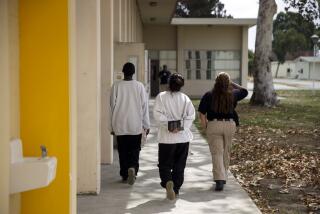Sheriff Tells Sad State of Enforcement : Crime: Jim Roache testifies in a Superior Court hearing on the equity of tax disbursements that a lack of funds leaves policing of the county in ‘chaos.’
Sheriff Jim Roache, offering a Superior Court judge a close-up look at the “chaos” in county law enforcement, testified Tuesday that years of severe funding shortages have allowed violent criminals to roam the streets and left San Diegans with inadequate police protection.
Roache, who took the stand as a witness in the county lawsuit over property tax disbursements, recited an alarming, familiar list of statistics on critical staff, facility and equipment shortages in his department, which operates county jails and polices much of suburban and rural San Diego.
For the record:
12:00 a.m. Sept. 5, 1991 For the Record
Los Angeles Times Thursday September 5, 1991 San Diego County Edition Metro Part B Page 8 Column 2 Metro Desk 3 inches; 74 words Type of Material: Correction
Law enforcement--The inadvertent omission of two words in a Wednesday story about the crisis in law enforcement changed the meaning of a statement by Cecil Steppe, the county’s chief probation officer. The sentence should have read:
“Also testifying Tuesday was Cecil Steppe, the county’s chief probation officer, who told Greer that some probation officers are assigned to as many as 500 people--a level of supervision that allows for no face-to-face visits, telephone calls or other follow-up on probationers.”
Under questioning from County Atty. Michael Poynor, Roache lamented a dire shortage of jail beds; a crime lab with equipment so antiquated that prosecutions are jeopardized; patrol cars with nearly 100,000 miles on them; dangerously outmoded communication equipment and many other deficiencies.
The jail bed shortage and a backlog of 680,000 unserved warrants have brought the criminal justice system “to its knees,” Roache said. “I think I can fairly say . . . that the criminal justice system is in chaos.”
Roache was invited last week to testify by Superior Court Judge Michael I. Greer, who told county lawyers he wanted to hear firsthand how inequities in property tax revenue distribution affect county law enforcement.
The county alleges in the 1986 lawsuit that it has been shortchanged nearly $1 billion because of an inequitable tax allocation system devised by the Legislature in 1979, after the passage of Proposition 13.
During the 1989-90 fiscal year, for example, San Diego County received about $94 million less than it would have if the formula entitled the county to the statewide average for property tax revenue.
In implementing Proposition 13, the Legislature developed a property tax distribution formula based on local governments’ previous levels of taxation. Because San Diego County had relatively low taxes and spending on services at the time, the formula left it with a smaller share of property tax dollars than cities such as San Francisco, which were assessing higher taxes.
Lawyers for both sides said that Greer is attempting to determine whether the inequity violates San Diegans’ fundamental right to safety, as outlined in the state Constitution. A conclusion that citizen safety is jeopardized would allow Greer to use a legal test that would make the county’s case substantially easier to prove.
A lawsuit now pending before the state Supreme Court may decide some questions about the state’s property tax distribution formula, Poynor said, but a decision probably will not be made before Greer rules in the San Diego suit. That gives the judge the opportunity to decide on the county’s request to throw out the legislation establishing the formula, he said.
Also testifying Tuesday was Cecil Steppe, the county’s chief probation officer, who told Greer that some probation officers are assigned to as many as 500 people--a level of supervision that allows face-to-face visits, telephone calls or other follow-up on probationers.
Such case officers merely receive reports from employers or probationers themselves, who have been deemed the least dangerous of the 19,000 people supervised by the department. In such cases, Steppe said, “I have absolutely no way of knowing what’s going on.”
Dramatic staff shortages also cause long delays in reports that Steppe’s department prepares for judges considering whether to grant probation to a convict. The staff of juvenile institutions, overseen by the department, is also inadequate, he said.
Outlining the county’s jail shortage, Roache estimated that he needs about 7,000 beds to hold suspects awaiting trial and convicts serving short sentences, but the county has just 2,345 beds. Under a court order in a lawsuit on jail crowding, the Sheriff’s Department is allowed to cram 3,829 people into its six jails.
The crowding causes police and sheriffs to cite and release even violent criminals. Those arrested are failing to show up in court because they know that their chances of spending any time in jail are minimal.
“So few beds are available for so many offenders . . . that what few beds we do have available we retain for violent offenders--the murderer, robber, rapist, child molester,” Roache said. “We are sending the implicit message that there is no necessity for you to show up in court because a warrant is going to be issued, and no one’s going to come find you.”
The county also cannot open the recently completed East Mesa Jail, which would house 1,500 prisoners, because it does not have the $20 million in annual operating costs. A plan is being readied to close the El Cajon and Las Colinas men’s jails, and transfer inmates and staff to East Mesa.
The county’s legal argument includes the claim that the inequitable property tax formula forces San Diegans to levy additional fees and taxes on themselves, such as the half-cent sales tax increase approved in 1988 for jail and court construction. Expenditure of that money, which now totals nearly $275 million, is being held up by a separate lawsuit on the constitutionality of the tax increase.
Roache also said that the Sheriff’s Department can allocate just 0.48 patrol deputies for every 1,000 residents in the nine cities and unincorporated areas it covers, less than half the number that should be assigned. Rural areas such as Spring Valley and Fallbrook receive even more minimal coverage.
The 54% increase in deputies since 1982 has not kept pace with the 87% rise in violent crime during the same period, he said. Roache estimated that he needs a $200-million budget to run the department this year, but has been limited to $132 million because of continued fund shortages.
In other testimony, Roache:
* Called the county crime lab “a disaster,” adding that “we are losing prosecutions because my crime lab has insufficient staff and equipment.”
* Claimed that half of the backlog of 100 unsolved homicides could be resolved if the department had the staff.
* Said his department will lose its SWAT team and public affairs unit if severe county budget cuts for fiscal year 1991-92 are implemented.
* Said that 75% to 80% of his department’s vehicles will have more than 100,000 miles on them by the end of this year.
More to Read
Sign up for Essential California
The most important California stories and recommendations in your inbox every morning.
You may occasionally receive promotional content from the Los Angeles Times.










